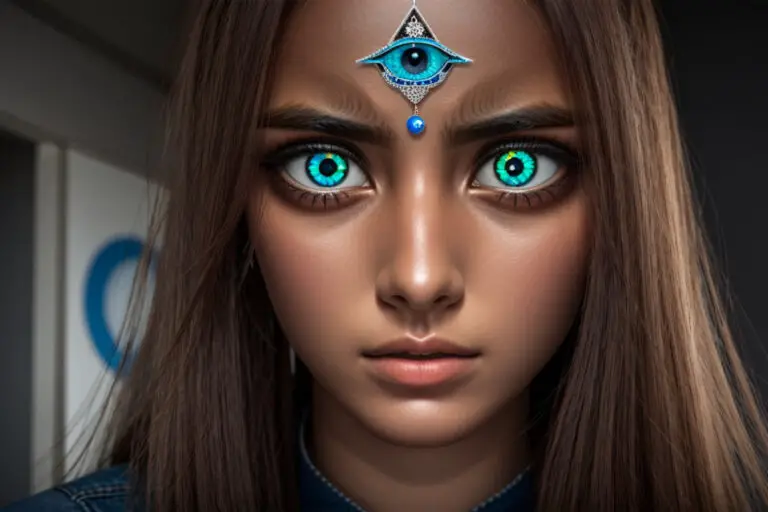Evil Eye History South Asian Countries: Explained
Important Takeaways: Evil Eye History South Asian Countries
One of the key takeaways when exploring the history of the evil eye in South Asian countries is the deeply rooted belief in its existence and power.
Throughout centuries, people in India, Pakistan, Bangladesh, Sri Lanka, and Nepal have regarded the evil eye as a potent force capable of inflicting harm.
This belief has shaped various cultural practices and rituals aimed at warding off its malevolent effects.
Another important takeaway is the prevalence of talismans and amulets as protective measures against the evil eye.
In South Asian countries, it is common to find individuals wearing or carrying objects believed to possess magical properties that can repel or neutralize the effect of this envious gaze.
These objects range from simple charms made from specific materials like glass or metal to intricate designs engraved on jewelry or incorporated into household items.
Furthermore, it is worth noting that rituals and ceremonies play a significant role in protecting oneself from the evil eye’s influence.
In these countries, special prayers are chanted, incense is burned, and various offerings are made to counteract any negative energies caused by jealousy or envy.
These rituals often involve family members gathering together and seeking blessings from religious figures who have expertise in combating the evil eye.
Additionally, an interesting takeaway from examining the history of the evil eye in South Asian countries is how social dynamics can be influenced by this belief system.
In some communities, individuals who are considered to possess a particularly powerful gaze may be viewed with caution or even fear due to their perceived ability to inflict harm through their eyes alone.
This can create certain social hierarchies where people strive to protect themselves by avoiding contact with those believed to possess such powers.
Understanding how beliefs surrounding the evil eye have evolved over time provides insight into cultural continuity within these regions.
Despite modernization and globalization influences, many South Asians still hold strong convictions about this ancient phenomenon.
It serves as a reminder that traditions deeply ingrained in a society’s fabric can persist and shape people’s daily lives, even in an era of rapid change.
These important takeaways shed light on the enduring significance of the evil eye in South Asian cultures, highlighting the strong belief systems, protective talismans, rituals and ceremonies, social dynamics, and cultural continuity that surround this phenomenon.
By delving into these aspects, one can gain a deeper appreciation for the rich tapestry of beliefs and practices that have shaped the history of the evil eye in South Asian countries.
Everything you need to know about the EVIL EYE!!
Here is a list of the countries in South Asia that believe in the evil eye:
Evil Eye History South Asian Countries. South Asia is a region teeming with diverse cultures and ancient traditions, many of which include a belief in the evil eye.
In India, the concept of the evil eye is deeply rooted in Hindu mythology and religious texts.
It is often associated with the powerful goddess Durga, who is said to possess a third eye that can protect against malevolent gazes.
The evil eye holds great significance in Indian culture, with various symbols and amulets used for protection against its effects.
In Pakistan, the evil eye is believed to have the power to cause harm or misfortune to individuals or their possessions.
It is considered a pervasive superstition among different communities and is taken very seriously.
People may resort to wearing protective talismans or reciting prayers for safeguarding themselves from its influence.
Similarly, in Bangladesh, the belief in the evil eye runs deep within the cultural fabric.
This belief often intertwines with elements of traditional folk religion and Islam.
Bangladeshis may use various methods for warding off the evil eye, such as wearing amulets or tying black threads around their wrists or necks.
Sri Lanka has its own unique blend of beliefs regarding the evil eye.
The concept finds roots both in Buddhism and Hinduism, two major religions practiced on the island.
In Sri Lankan folklore, there are tales of supernatural beings holding malicious intentions through casting an envious gaze upon others.
To counteract this perceived threat, Sri Lankans engage in practices like chanting protective mantras or using amulets containing sacred symbols.
Nepal too shares a similar reverence for protection against the evil eye. Here it finds expression through cultural practices deeply embedded within Nepalese society.
For instance, during auspicious occasions like weddings or childbirths, people hang lemon-chili garlands outside their homes as a symbolic defense mechanism against negative energies caused by envy.
The belief in the evil eye across South Asia showcases not only its cultural significance but also its ability to transcend religious and national boundaries.
These beliefs have been passed down through generations, intertwining with local folklore and legends, becoming an inseparable part of the region’s mystical tapestry.
Whether through amulets, prayers, or rituals, the people of South Asia continue to honor their ancient traditions and seek protection from this universal force believed to bring harm and misfortune.
What Is The History of the evil eye in India?
In India, the concept of the evil eye has a long and rich history, deeply rooted in ancient traditions and cultural beliefs.
Evil eye mythology has been passed down through generations, shaping people’s understanding of this powerful force.
It is believed that the evil eye can bring misfortune, illness, or even death upon its victims.
Evil eye practices in India vary across different regions and communities but often involve rituals aimed at warding off its negative effects.
One common practice is the use of protective talismans or amulets such as the “nazar battu” or “nazar suraksha kavach,” which are believed to have the power to deflect the gaze of an evil eye.
These talismans can be found in various forms like pendants, bracelets, or even hanging charms.
The belief in the evil eye holds great significance in Indian culture and is deeply rooted in religious texts and ancient civilizations.
References to the evil eye can be found in Hindu scriptures like the Atharva Veda as well as mythological stories from epics like Ramayana and Mahabharata.
In these tales, characters are often depicted using specific rituals or protective measures to guard against the malevolent effects of the evil eye.
Folklore surrounding the evil eye also thrives in Indian communities.
Legends are told about miraculous escapes from its malevolence or instances where people have fallen victim to its curse.
These stories add depth and meaning to people’s beliefs about protection against this mystical force.
Superstitions related to protecting oneself from the evil eye are prevalent in Indian households.
From hanging lemons with green chilies outside homes to using specific herbs like neem leaves for purification purposes, there are numerous customs practiced across different regions to safeguard against its influence.
The historical references of the evil eye phenomenon within India paint a picture of a deeply ingrained cultural belief system that has stood strong over centuries.
Whether it is the ancient civilizations that flourished in the region or the diverse religious practices and folklore, the evil eye continues to hold its place as a potent force in Indian society.

What Is The History of the evil eye in Pakistan?
In Pakistan, the belief in the evil eye runs deep within the culture and has a fascinating history.
Evil eye practices have been prevalent in this region for centuries, shaping the way people perceive and protect themselves from its malevolent effects.
The concept of the evil eye in Pakistan shares similarities with other cultures that believe in its power to cause misfortune or harm.
Historical references to the evil eye can be found in old manuscripts and folklore, shedding light on its enduring significance.
In ancient civilizations like Indus Valley and Gandhara, there are traces of evil eye symbolism depicted in their art and sculptures.
These ancient traditions merged with local customs over time, creating a unique blend of beliefs surrounding the evil eye.
The mythology surrounding the evil eye has also found its place within Pakistani folklore.
Stories of ordinary individuals falling victim to its curse or miraculous tales of protection against its gaze have been passed down through generations.
People strongly believe that certain individuals possess a powerful gaze capable of inflicting harm simply by looking at others with envy or ill intentions.
Protection against the evil eye is an integral part of Pakistani culture.
Amulets and talismans believed to ward off its effects are commonly worn or displayed in homes and businesses.
These protective objects include various symbols like blue beads known as “Nazar battu” or “Nazar lagna,” which are believed to absorb any negative energy directed towards them.
Religious texts, such as verses from the Quran, also play a significant role in protecting against the evil eye.
Prayers invoking divine intervention and seeking refuge from envious gazes are recited to counteract any potential harm caused by this mystical force.
While some may dismiss these beliefs as mere superstitions, it is important to recognize their cultural significance and impact on daily life for many Pakistanis.
The belief in the evil eye serves as both an explanation for misfortune and a way to seek protection against it – a deeply ingrained aspect of the country’s rich cultural tapestry.
What Is The History of the evil eye in Bangladesh?
In the enchanting land of Bangladesh, the evil eye has a captivating history steeped in rich folklore and deep-rooted beliefs.
This ancient tradition dates back centuries and continues to hold great significance in Bangladeshi culture today.
Bangladesh has a strong belief in the power of the evil eye, which is referred to as “Nazar” in the local language.
It is believed that certain individuals possess an innate ability to cast this malevolent gaze, capable of bringing misfortune or even harm to others.
The concept of Nazar has woven itself into the fabric of daily life, influencing various aspects of Bangladeshi society.
Evil eye mythology in Bangladesh tells tales of powerful spirits and wicked sorcery carried out by envious individuals.
These stories are passed down through generations, serving as cautionary reminders to be wary of the evil eye’s influence.
Folklore surrounding Nazar reveals numerous accounts where individuals have fallen victim to its malevolence.
Legends speak of sudden bouts of illness or streaks of bad luck attributed to an envious glance.
As a result, Bengalis have developed various superstitions and protective measures against this perceived threat.
To ward off the evil eye, many people in Bangladesh engage in specific rituals or wear protective amulets known as “taweez” or “tabiz.”
These amulets are often inscribed with sacred verses from religious texts such as the Quran and are believed to offer divine protection against malevolent forces.
The cultural significance of Nazar extends beyond individual beliefs and practices and seeps into broader societal customs.
In Bangladesh, it is common for newborn babies or newlyweds to be adorned with black kohl around their eyes as a form of protection against the evil eye’s influence.
This practice reflects not only a belief in supernatural forces but also serves as a symbol representing their vulnerability and need for safeguarding.
In ancient civilizations like Bengal, where religion plays a prominent role, references to the evil eye can be found in religious texts.
Many believe that the Quran and other religious scriptures contain verses that offer protection from the malevolent gaze.
The evil eye’s influence is pervasive in Bangladeshi culture, transcending social and economic boundaries.
Regardless of one’s background or education, it is not uncommon to find individuals who strongly adhere to the beliefs surrounding Nazar.
Bangladesh bears witness to a significant history of belief in the evil eye.
With its deep-rooted cultural significance and prevalence in everyday life, the concept of Nazar continues to shape the beliefs and practices of the Bangladeshi people.
Whether through protective rituals, amulets, or cultural customs, this powerful tradition remains an integral part of their identity and collective consciousness.

What Is The History of the evil eye in Sri Lanka?
In Sri Lanka, the belief in the evil eye is deeply rooted in the culture and has a long-standing history.
This belief can be traced back to ancient times when various civilizations and cultures inhabited the region.
The evil eye holds a significant place in Sri Lankan folklore and mythology, with numerous stories and legends surrounding its existence.
According to local beliefs, the evil eye is considered a malevolent gaze that can bring harm or misfortune upon its recipients.
It is believed that certain individuals possess this power unknowingly, causing unintentional harm to others through their envious or jealous looks.
To protect themselves from the evil eye’s influence, people in Sri Lanka follow various practices and superstitions.
One prevalent practice is using amulets or talismans known as “nazar battu” to ward off the evil eye’s negative effects.
These amulets are often made of blue glass and are believed to possess protective properties against the malevolent gaze.
Additionally, some individuals wear black threads or tie pieces of cloth around their wrists or necks as a form of protection.
The cultural significance of the evil eye in Sri Lanka goes beyond just superstitions and practices.
It also finds its place within religious texts and traditions.
For instance, in Buddhist culture, there are references to protecting oneself from “nazar dosh,” which refers to the harmful effects of the evil eye.
Similarly, Hinduism acknowledges the presence of such negative energies and offers rituals and prayers as means of safeguarding against them.
Moreover, Sri Lankan society might have unique interpretations when it comes to symbolism surrounding the evil eye.
Some individuals may associate specific animals or objects with warding off its negative effects.
For example, a common belief is that placing peacock feathers near homes can prevent any harm caused by an evil gaze.
Overall, while each culture might have different variations of beliefs surrounding the evil eye phenomenon, Sri Lanka has its rich history intertwined with these superstitions, cultural practices, and religious customs.
The people’s firm belief in the existence of the evil eye and their efforts to protect themselves highlight the significant impact this age-old tradition continues to have on Sri Lankan society.
What Is The History of the evil eye in Nepal?
Nepal, a land of rich culture and traditions, also holds its own beliefs regarding the evil eye. In Nepali culture, the evil eye is known as “Buri Nazar” or “Drishti.”
It is believed that certain individuals possess the power to cast an evil eye unintentionally, causing harm to others.
This belief stems from a deep-rooted fear of negative energy and its potential effects on one’s well-being.
Evil eye superstitions have been passed down through generations in Nepal.
People often attribute misfortunes such as illness, accidents, or financial difficulties to the malevolent gaze of others.
To ward off the effects of Buri Nazar, various protective measures are taken.
One common practice is hanging charms or amulets called “Nazar Battu” in homes and vehicles as a form of deterrent against evil eyes.
The concept of Buri Nazar finds its place not only in everyday life but also in religious texts and ancient traditions.
Hindu mythology talks about the evil eye’s presence in legends and folklore. It is believed that even gods and goddesses are susceptible to the influence of negative energy caused by an evil eye.
To counteract Buri Nazar’s harmful effects, people in Nepal perform rituals and prayers seeking protection from higher powers.
They may visit temples or consult spiritual practitioners for remedies and guidance.
Additionally, holy symbols like Swastika (a symbol representing good luck) may be used to ward off evil spirits associated with the evil eye.
Nepal has its own distinct beliefs surrounding the existence and impact of the evil eye.
The historical references found within cultural practices give insights into how deeply ingrained these beliefs are within society.
The superstitions tied to this phenomenon continue to shape daily life as individuals take precautions against potentially negative influences caused by an unwanted gaze.
Final Thoughts
The concept of the evil eye holds great significance in the history and culture of South Asian countries.
Throughout centuries, people in these regions have strongly believed in its power to bring misfortune and protect themselves from its gaze.
The history of the evil eye in South Asia is deeply rooted in ancient traditions and has evolved over time.
It has been passed down through generations, with stories and remedies being shared among families and communities.
The belief in the evil eye is not just limited to rural areas but also prevails in urban settings, where people continue to take precautions against it.
The rituals and remedies associated with warding off the evil eye are diverse and reflect a rich cultural heritage.
From wearing talismans, such as amulets or black threads, to performing elaborate rituals involving prayers, incense, and offerings, there are various ways that individuals seek protection.
Moreover, the influence of religion on this belief cannot be ignored.
In predominantly Hindu regions like India and Nepal, it is common to see homes adorned with symbols like Om or Swastika as a means of warding off negative energies.
Similarly, Islamic traditions emphasize reciting specific verses from the Quran or using objects like blue beads for protection against the evil eye.
Despite advancements in science and technology, belief in the evil eye remains deeply ingrained within South Asian societies.
It serves as a reminder of their cultural roots and acts as a source of comfort during times of uncertainty or adversity.
Whether one fully believes in its power or not, understanding the history and cultural significance of the evil eye allows us to appreciate its role within South Asian communities.
It offers an insight into their beliefs, practices, and their desire for protection from any harm that may come their way.
Frequently Asked Questions
What is the evil eye and its significance in South Asian culture?
The evil eye, known as “nazar” in South Asia, holds deep cultural significance in countries like India, Pakistan, Bangladesh, Sri Lanka, and Nepal. It refers to the belief that certain individuals possess the power to unintentionally cause harm or misfortune by simply casting an envious glance toward someone or something.
This belief dates back centuries and is deeply ingrained in the fabric of South Asian culture. The evil eye is seen as a form of negative energy that can bring about illness, bad luck, or even financial ruin.
To protect against its effects, people have developed various rituals and talismans believed to ward off the evil eye.
What are some common signs of being affected by the evil eye?
According to popular folklore, there are several signs that indicate someone has been affected by the evil eye. These signs can vary from person to person but often include feelings of sudden fatigue or weakness, unexplained headaches or body pains, a sudden decline in overall well-being or mood swings without any apparent reason.
Additionally, individuals may notice changes in their personal or professional lives such as encountering constant obstacles or setbacks despite their best efforts. In extreme cases, one might experience a series of unfortunate events that seem unusually coincidental.
How do people protect themselves from the evil eye?
Protecting oneself from the effects of the evil eye is of paramount importance in South Asian culture.
Various methods are employed for this purpose including wearing talismans like amulets or charms such as a nazar battu (a blue glass bead), which is believed to absorb any negative energy directed towards the wearer; tying black threads around wrists or necks; smudging with sacred herbs like sage; and performing rituals involving prayers and recitation of specific verses from religious texts.
Are there any scientific explanations for beliefs surrounding the evil eye?
While the belief in the evil eye is deeply rooted in cultural traditions, scientific explanations are subjective and lack concrete evidence. Some theories suggest that the evil eye may be attributed to psychological factors such as suggestibility or self-fulfilling prophecies.
Others argue that it could be a result of social dynamics and envy playing a role in influencing individuals’ perceptions or behavior. However, it is important to respect different cultural beliefs and interpretations and understand that science may not always provide a comprehensive explanation for every aspect of human experience.
How does the belief in the evil eye impact daily life in South Asian countries?
The belief in the evil eye has a significant impact on daily life in South Asian countries.
It shapes various aspects of social interactions, family dynamics, and personal choices. From newborns being adorned with amulets to protect them from potential harm caused by envious glances, to regular rituals performed during occasions like weddings or before embarking on important journeys, the presence of the evil eye is ever-present.
Additionally, it influences decision-making processes regarding business ventures, personal accomplishments, and even relationships to ensure protection against any perceived negative influences. The concept of the evil eye holds immense importance in South Asian culture due to its historical roots and deep-seated beliefs.
Resource page
| Resource | Link |
|---|---|
| 1. Blumhouse’s Evil Eye is putting South Asian stories to the forefront – Cold Tea Collective | 1 |
| 2. Evil eye – Wikipedia | 2 |
| 3. Chapter 4: Other Beliefs and Practices – Pew Research Center | 3 |
| 4. Evil eye: Five ways people in the Middle East ward it off – Middle East Eye | 4 |
| 6. The strange power of the ‘evil eye’ – BBC | 6 |
| 7. What Each Culture and Country Believe About The Evil Eye – Svana Design | 7 |
| 8. What Is The Evil Eye? The Meaning, History & Myths Of This Common Symbol – YourTango | 8 |
- Evil Eye Hand: Unveiling the Mystical Origins and Meanings - February 2, 2024
- Amegreen Amethyst Meaning: Discover the Hidden Magic! - February 2, 2024
- Is The Evil Eye Bad?: A Deep Dive into Evil Eye Taboos - February 2, 2024








